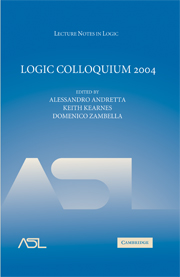Book contents
- Frontmatter
- Contents
- Introduction
- Speakers and Titles
- Abstract elementary classes: some answers, more questions
- On the density of Hausdorff ultrafilters
- Zero-groups and maximal tori
- Constructive set theory with operations
- Parametrized local zeta functions
- Colourings of hypergraphs, permutation groups and CSP's
- Tolerance intersection properties and subalgebras of squares
- Universes in type theory part I—Inaccessibles and Mahlo
- Hausdorff-dimension and weak truth-table reducibility
- Computation and the explanation of intelligent behaviours: ethologically motivated restart
- Constructible sheaves and definability
- An overview of modern universal algebra
- Lecture Notes in Logic
Constructible sheaves and definability
Published online by Cambridge University Press: 05 July 2014
- Frontmatter
- Contents
- Introduction
- Speakers and Titles
- Abstract elementary classes: some answers, more questions
- On the density of Hausdorff ultrafilters
- Zero-groups and maximal tori
- Constructive set theory with operations
- Parametrized local zeta functions
- Colourings of hypergraphs, permutation groups and CSP's
- Tolerance intersection properties and subalgebras of squares
- Universes in type theory part I—Inaccessibles and Mahlo
- Hausdorff-dimension and weak truth-table reducibility
- Computation and the explanation of intelligent behaviours: ethologically motivated restart
- Constructible sheaves and definability
- An overview of modern universal algebra
- Lecture Notes in Logic
Summary
Introduction. Several applications of model-theoretic methods in the theory of cohomology have appeared recently, most probably influenced by ideas of Macintyre. In his programmatic paper [10], he shows that, after expanding the language of rings by certain sorts and predicates for cohomology, the axioms of Weil cohomology theories are first order and one can form new cohomology theories as ultraproducts of already existing ones.
The present author has remarked that, although the cohomologies with torsion coefficients do not satisfy the axioms for a Weil cohomology theory individually, they do so “on average”, and one can obtain cohomologies with coefficients in pseudofinite fields of characteristic zero by taking ultraproducts [13]. He shows that this “pseudofinite cohomology” is at least as good as the l-adic theory when dealing with issues around the Weil conjectures. In parallel, Brunjes and Serpe developed the theory of nonstandard sheaves systematically, and they even show that the pseudofinite cohomology is better behaved than the l-dic one, the former being a derived functor cohomology [1].
The purpose of this short note is to clarify which aspects and invariants of the theory of (étale) constructible sheaves and cohomologies are definable in the language of rings. It should serve as a bridge between the algebraic-geometric and model-theoretic language and should encourage model-theorists to use the sophisticated techniques already developed by geometers. We show that, in case one needs to consider an invariant defined in terms of constructible sheaves over a finite or a pseudofinite ground field, there is a good chance that it is definable.
- Type
- Chapter
- Information
- Logic Colloquium 2004 , pp. 187 - 196Publisher: Cambridge University PressPrint publication year: 2007

